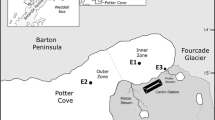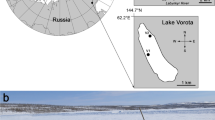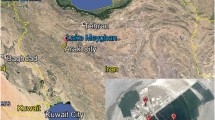Abstract
Saline, meromictic lakes with significant depth are usually formed as a result of salt mining activity. Ocnei Lake is one of the largest Transylvanian (Central Romania) neutral, hypersaline lake of man-made origin. We aimed to survey the seasonal dynamics of archaeal diversity in the water column of Ocnei Lake by employing microbiological methods as well as molecular techniques based on the sequence analysis of the 16S rRNA gene. We found that archaeal diversity in the water column increased with depth and salinity, with 8 OTUs being detected in the epilimnion compared to 21 found in the chemocline, and 32 OTUs in the monimolimnion. Down to 3.5 m depth, the archaeal community was markedly dominated by the presence of an unclassified archaeon sharing 93 % sequence identity to Halogeometricum spp. At the chemocline, the shift in archaeal community composition was associated with an increase in salinity, the main factor affecting the vertical distribution of archaeal assemblages. It appears that the microoxic and hypersaline monimolimnion is populated by several major haloarchaeal taxa, with minor fluctuations in their relative abundances throughout all seasons. The culturable diversity was reasonably correlated to the dominant OTUs obtained by molecular methods. Our results indicate that Ocnei Lake represents a relatively stable extreme habitat, accommodating a diverse and putatively novel archaeal community, as 30 % of OTUs could not be classified at the genus level.






Similar content being viewed by others
References
Alexe M (2010) Studiul lacurilor sărate din Depresiunea Transilvaniei. Ed. Presa Universitară Clujeană, Cluj Napoca (In Romanian)
Alexe M, Furtună P (2012) Natural and anthropic risks in the area of Durgău-Valea Sărată Turda salt lakes. In: Gâştescu P, Lewis W Jr, Breţcan P (eds) Water resources and wetlands. Tulcea, Romania, pp 244–247
Alinei R, Ionica A, Cheratoiu C, Cicu A, Gheorghiţa D, Guzu D, Falamas R, Bucurenciu C, Arimie B, Mironescu M, Oprean L (2006) Isolation of halophilic microorganisms in the saline lakes from Ocna Sibiului and anlaysis of red pigments production. Acta Univ Cibiensis E Food Technol 10:21–33
Amoozegar MA, Makhdoumi-Kakhki A, Shahzadeh Fazeli SA, Azarbaijani R, Ventosa A (2012) Halopenitus persicus gen. nov., sp. nov., an archaeon from an inland salt lake. Int J Syst Evol Microbiol 62:1932–1936
Andrei AŞ, Banciu HL, Oren A (2012) Living with salt: metabolic and phylogenetic diversity of archaea inhabiting saline ecosystems. FEMS Microbiol Lett 330:1–9
Antunes A, Taborda M, Huber R, Moissl C, Nobre MF, da Costa MS (2008) Halorhabdus tiamatea sp. nov., a non-pigmented, extremely halophilic archaeon from a deep-sea, hypersaline anoxic basin of the Red Sea, and emended description of the genus Halorhabdus. Int J Syst Evol Microbiol 58:215–220
Atlas MR (2004) Handbook of microbiological media, 3rd edn. CRC Press, London
Bayly I, Williams WD (1973) Inland waters and their ecology. Longman Australia, Melbourne
Benlloch S, López-López A, Casamayor EO, Øvreås L, Goddard V, Daae FL, Smerdon G, Massana R, Joint I, Thingstad F, Pedrós-Alió C, Rodríguez-Valera F (2002) Prokaryotic genetic diversity throughout the salinity gradient of a coastal solar saltern. Environ Microbiol 4:349–360
Boehrer B, Schultze M (2008) Stratification of lakes. Rev Geophys 46: RG2005
Borsodi AK, Felföldi T, Máthé I, Bognár V, Knáb M, Krett G, Jurecska L, Tóth EM, Márialigeti K (2013) Phylogenetic diversity of bacterial and archaeal communities inhabiting the saline Lake Red located in Sovata, Romania. Extremophiles 17:87–98
Bowman JP, McCammon SA, Rea SM, McMeekin TA (2000) The microbial composition of three limnologically disparate hypersaline Antarctic lakes. FEMS Microbiol Lett 183:81–88
Bulgăreanu V (1996) Protection and management of anthroposaline lakes in Romania. Lakes Reserv Res Manag 2:211–229
Burns DG, Janssen PH, Itoh T, Kamekura M, Echigo A, Dyall-Smith ML (2010) Halonotius pteroides gen. nov., sp. nov., an extremely halophilic archaeon recovered from a saltern crystallizer. Int J Syst Evol Microbiol 60:1196–1199
Caporaso JG, Kuczynski J, Stombaugh J, Bittinger K, Bushman FD, Costello EK, Fierer N, Pena AG, Goodrich JK, Gordon JI, Huttley GA, Kelley ST, Knights D, Koenig JE, Ley RE, Lozupone CA, McDonald D, Muegge BD, Pirrung M, Reeder J, Sevinsky JR, Turnbaugh PJ, Walters WA, Widmann J, Yatsunenko T, Zaneveld J, Knight R (2010) QIIME allows analysis of high-throughput community sequencing data. Nat Methods 7:335–336
Chao A (1984) Nonparametric estimation of the number of classes in a population. Scand J Stat 11:265–270
Comeau AM, Harding T, Galand PE, Vincent WF, Lovejoy C (2012) Vertical distribution of microbial communities in a perennially stratified Arctic lake with saline, anoxic bottom waters. Sci Rep 2:604
Crognale S, Máthé I, Cardone V, Stazi SR, Ráduly B (2013) Halobacterial community analysis of Mierlei saline lake in Transylvania (Romania). Geomicrobiology 30:801–812
Cui HL, Gao X, Yang X, Xu XW (2010a) Halolamina pelagica gen. nov., sp. nov., a new member of the family Halobacteriaceae. Int J Syst Evol Microbiol 61:1617–1621
Cui HL, Yang X, Gao X, Li XY, Xu XW, Zhou YG, Liu HC, Zhou PJ (2010b) Halogeometricum rufum sp. nov., a halophilic archaeon from a marine solar saltern, and emended description of the genus Halogeometricum. Int J Syst Evol Microbiol 60:2613–2617
Cytryn E, Minz D, Oremland RS, Cohen Y (2000) Distribution and diversity of archaea corresponding to the limnological cycle of a hypersaline stratified lake (Solar lake, Sinai, Egypt). Appl Environ Microbiol 66:3269–3276
Dimitriu PA, Pinkart HC, Peyton BM, Mormile MR (2008) Spatial and temporal patterns in the microbial diversity of a meromictic soda lake in Washington State. Appl Environ Microbiol 74:4877–4888
Einen J, Thorseth IH, Ovreås L (2008) Enumeration of Archaea and Bacteria in seafloor basalt using real-time quantitative PCR and fluorescence microscopy. FEMS Microbiol Lett 282:182–187
Elevi Bardavid R, Khristo P, Oren A (2008) Interrelation between Dunaliella and halophilic prokaryotes in saltern crystallizer ponds. Extremophiles 12:5–14
Enache M, Itoh T, Kamekura M, Teodosiu G, Dumitru L (2007) Haloferax prahovense sp. nov., an extremely halophilic archaeon isolated from a Romanian salt lake. Int J Syst Evol Microbiol 57:393–397
Enache M, Itoh T, Kamekura M, Popescu G, Dumitru L (2008) Halophilic archaea isolated from man-made young (200 years) salt lakes in Slănic, Prahova, Romania. Cent Eur J Biol 3:388–395
Falb M, Müller K, Königsmaier L, Oberwinkler T, Horn P, von Gronau S, Gonzalez O, Pfeiffer F, Bornberg-Bauer E, Oesterhelt D (2008) Metabolism of halophilic archaea. Extremophiles 12:177–196
Hammer Ø, Harper DAT, Ryan P (2001) PAST: Paleontological Statistics Software Package for Education and Data Analysis. Palaeontologia Electronica 4. http://palaeo-electronica.org/2001_1/past/past.pdf
Humayoun SB, Bano N, Hollibaugh JT (2003) Depth distribution of microbial diversity in Mono Lake, a meromictic soda lake in California. Appl Environ Microbiol 69:1030–1042
Jiang H, Dong H, Yu B, Liu X, Li Y, Ji S, Zhang CL (2007) Microbial response to salinity change in Lake Chaka, a hypersaline lake on Tibetan plateau. Environ Microbiol 9:2603–2621
Keresztes ZG, Felföldi T, Somogyi B, Székely G, Dragos N, Márialigeti K, Bartha C, Vörös L (2012) First record of picophytoplankton diversity in Central European hypersaline lakes. Extremophiles 16:759–769
La Cono V, La Spada G, Arcadi E, Placenti F, Smedile F, Ruggeri G, Michaud L, Raffa C, De Domenico E, Sprovieri M, Mazzola S, Genovese L, Giuliano L, Slepak VZ, Yakimov MM (2013) Partaking of Archaea to biogeochemical cycling in oxygen-deficient zones of meromictic saline Lake Faro (Messina, Italy). Environ Microbiol 15:1717–1733
Lane D (1991) 16S/23S rRNA sequencing. In: Stackebrandt E, Goodfellow M (eds) Nucleic acid techniques in bacterial systematic. Wiley, New York, pp 115–175
Lauro FM, DeMaere MZ, Yau S, Brown MV, Ng C, Wilkins D, Raftery MJ, Gibson JA, Andrews-Pfannkoch C, Lewis M, Hoffman JM, Thomas T, Cavicchioli R (2011) An integrative study of a meromictic lake ecosystem in Antarctica. ISME J 5:879–895
Lay CY, Mykytczuk NC, Niederberger TD, Martineau C, Greer CW, Whyte LG (2012) Microbial diversity and activity in hypersaline high Arctic spring channels. Extremophiles 16:177–191
Lentini V, Gugliandolo C, Maugeri TL (2012) Vertical distribution of Archaea and Bacteria in a meromictic lake as determined by fluorescent in situ hybridization. Curr Microbiol 64:66–74
Makhdoumi-Kakhki A, Amoozegar MA, Bagheri M, Ramezani M, Ventosa A (2012a) Haloarchaeobius iranensis gen. nov., sp. nov., an extremely halophilic archaeon isolated from a saline lake. Int J Syst Evol Microbiol 62:1021–1026
Makhdoumi-Kakhki A, Amoozegar MA, Kazemi B, Pašić L, Ventosa A (2012b) Prokaryotic diversity in Aran-Bidgol salt lake, the largest hypersaline playa in Iran. Microbes Environ 27:87–93
Meuser JE, Baxter BK, Spear JR, Peters JW, Posewitz MC, Boyd ES (2013) Contrasting patterns of community assembly in the stratified water column of Great Salt Lake, Utah. Microb Ecol 66:268–280
Muntean V, Crişan D, Kiss S, Drăgan-Bularda M (1996) Enzymological classification of salt lakes in Romania. Int J Salt Lake Res 5:35–44
Mutlu MB, Martínez-García M, Santos F, Peña A, Guven K, Antón J (2008) Prokaryotic diversity in Tuz Lake, a hypersaline environment in Inland Turkey. FEMS Microbiol Ecol 65:474–483
Muyzer G, Waal EC, Uitterlinden AG (1993) Profiling of complex microbial populations by denaturing gradient gel electrophoresis analysis of polymerase chain reaction-amplified genes coding for 16S rRNA. Appl Environ Microbiol 78:1332–1334
Oren A (2001) The bioenergetic basis for the decrease in metabolic diversity at increasing salt concentrations: implications for the functioning of salt lake ecosystems. Hydrobiologia 466:61–72
Oren A (2002) Molecular ecology of extremely halophilic Archaea and Bacteria. FEMS Microbiol Ecol 39:1–7
Oren A (2013) Life at high salt and low oxygen: how do the Halobacteriaceae cope with low oxygen concentrations in their environment? Polyextremophiles, vol 27. Springer, Netherlands, pp 531–548
Oren A, Elevi R, Watanabe S, Ihara K, Corcelli A (2002) Halomicrobium mukohataei gen. nov., comb. nov., and emended description of Halomicrobium mukohataei. Int J Syst Evol Microbiol 52:1831–1835
Pagaling E, Wang H, Venables M, Wallace A, Grant WD, Cowan DA, Jones BE, Ma Y, Ventosa A, Heaphy S (2009) Microbial biogeography of six salt lakes in Inner Mongolia, China, and a salt lake in Argentina. Appl Environ Microbiol 75:5750–5760
Podell S, Ugalde JA, Narasingarao P, Banfield JF, Heidelberg KB, Allen EE (2013) Assembly-driven community genomics of a hypersaline microbial ecosystem. PLoS ONE 8:e61692
Scholten JC, Joye SB, Hollibaugh JT, Murrell JC (2005) Molecular analysis of the sulfate reducing and archaeal community in a meromictic soda lake (Mono Lake, California) by targeting 16S rRNA, mcrA, apsA, and dsrAB genes. Microb Ecol 50:29–39
Shannon C, Weaver W (1949) The mathematical theory of communication. University of Illinois Press, Champaign
Swan BK, Ehrhardt CJ, Reifel KM, Moreno LI, Valentine DL (2010) Archaeal and bacterial communities respond differently to environmental gradients in anoxic sediments of a California hypersaline lake, the Salton Sea. Appl Environ Microbiol 76:757–768
Tourna M, Stieglmeier M, Spang A, Könneke M, Schintlmeister A, Urich T, Engel M, Schloter M, Wagner M, Richter A, Schleper C (2011) Nitrososphaera viennensis, an ammonia oxidizing archaeon from soil. Proc Natl Acad Sci USA 108:8420–8425
Wainø M, Tindall BJ, Ingvorsen K (2000) Halorhabdus utahensis gen. nov., sp. nov., an aerobic, extremely halophilic member of the Archaea from Great Salt Lake, Utah. Int J Syst Evol Microbiol 50:183–190
Yanan Y, Breitbart M, McNairnie P, Rohwer F (2006) FastGroupII: A web-based bioinformatics platform for analyses of large 16S rDNA libraries. BMC Bioinformatics 7
Youssef NH, Ashlock-Savage KN, Elshahed MS (2012) Phylogenetic diversities and community structure of members of the extremely halophilic Archaea (order Halobacteriales) in multiple saline sediment habitats. Appl Environ Microbiol 78:1332–1344
Acknowledgments
This work was supported by grants of the Romanian National Authority for Scientific Research, CNCS–UEFIS-CDI, project numbers PN-II-ID-PCE-2011-3-0546 and PN-II-ID-PCE-2011-3-0765. We thank Dr. Cosmin Sicora for technical support in qPCR analysis. We are grateful to Dr. Ovidiu Mera for the permission to enter the study area, and to Prof. Elena Rakosy and Prof. Constantin Crăciun for their consent to use the microscopy facilities.
Author information
Authors and Affiliations
Corresponding author
Additional information
Communicated by A. Oren.
Electronic supplementary material
Below is the link to the electronic supplementary material.
Rights and permissions
About this article
Cite this article
Baricz, A., Coman, C., Andrei, A.Ş. et al. Spatial and temporal distribution of archaeal diversity in meromictic, hypersaline Ocnei Lake (Transylvanian Basin, Romania). Extremophiles 18, 399–413 (2014). https://doi.org/10.1007/s00792-013-0625-6
Received:
Accepted:
Published:
Issue Date:
DOI: https://doi.org/10.1007/s00792-013-0625-6




